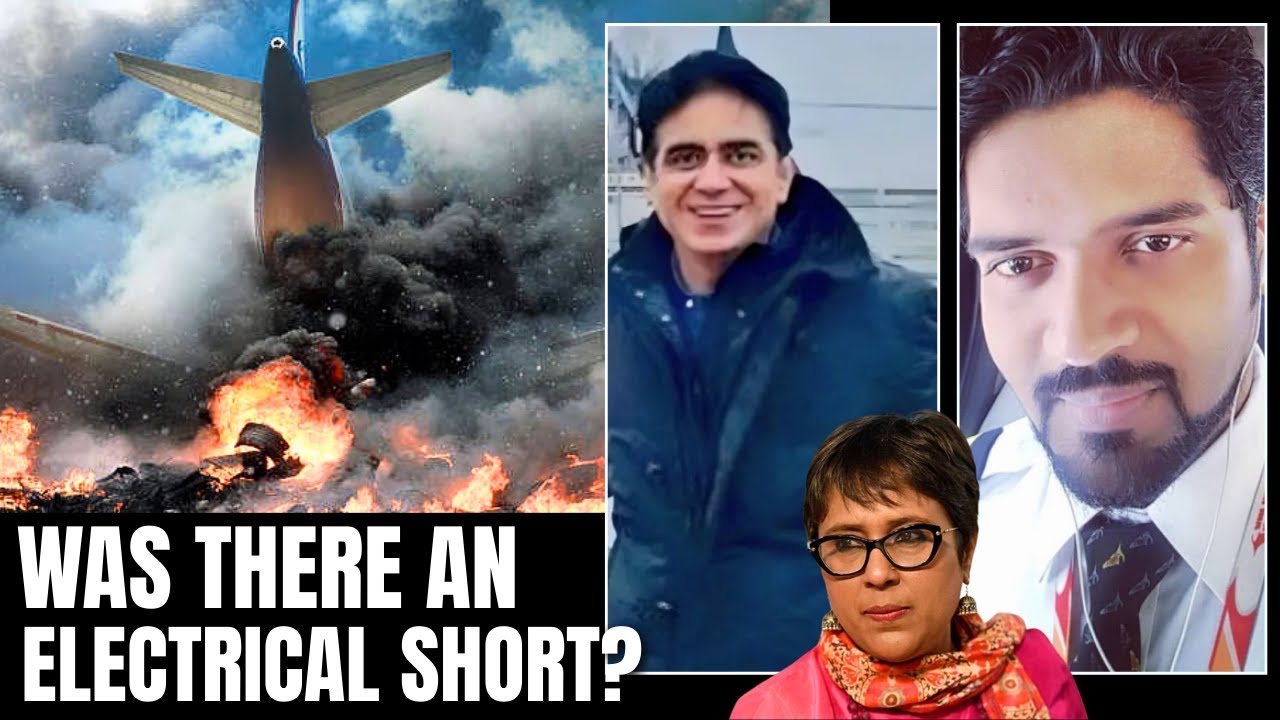😱 BOMBSHELL REVEAL: The tragic Air India Flight 171 crash just took a jaw-dropping turn! 💥 Was it a water leak, an electrical short, or something even more sinister that brought down the Boeing 787? Families of the 260 victims are now fighting back, suing Boeing for answers—and what they’ve uncovered will leave you speechless. Could this change aviation forever?
Click to dive into the chilling details!

On June 12, 2025, Air India Flight AI-171, a Boeing 787-8 Dreamliner bound for London Gatwick, crashed moments after takeoff from Ahmedabad’s Sardar Vallabhbhai Patel International Airport, claiming 260 lives—229 passengers, 12 crew members, and 19 people on the ground. The tragedy, one of India’s deadliest aviation disasters, initially baffled investigators. A preliminary report pointed to fuel cut-off switches being flipped seconds after takeoff, but a dramatic twist has emerged: allegations of a water leak or electrical short in the aircraft’s systems. Families of the victims, seeking accountability, have filed lawsuits against Boeing, represented by prominent U.S. attorney Mike Andrews of Beasley Allen Law Firm. This article explores the crash, the evolving investigation, the lawsuits, and their potential to reshape aviation safety, drawing on official reports, expert analyses, and legal developments.
The Crash: A Catastrophic Sequence
Flight AI-171 lifted off at 13:39 IST, climbing to just 625 feet before losing thrust and crashing into the hostel block of B.J. Medical College, 1.7 kilometers from the runway. The Boeing 787-8, registered VT-ANB, was destroyed, killing all but one aboard—Vishwas Kumar Ramesh—and 19 on the ground, including medical students. The scale of the disaster, with 181 Indian and 52 British nationals among the victims, sent shockwaves globally.
The Aircraft Accident Investigation Bureau (AAIB) of India, with support from the U.S. National Transportation Safety Board (NTSB), the UK’s Air Accidents Investigation Branch, and Boeing, released a preliminary report on July 8, 2025. It revealed a chilling detail: both engines’ fuel control switches moved from “RUN” to “CUTOFF” seconds after takeoff, starving the engines and causing a total power loss. Cockpit voice recorder (CVR) data captured one pilot asking, “Why did you do the cut-off?” with the other responding, “I didn’t.” The switches were returned to “RUN,” triggering an automatic engine relight, but one engine was still recovering thrust when the plane crashed.
This initial focus on pilot action sparked controversy. The India Commercial Pilots’ Association (ICPA) condemned speculative claims of pilot error or suicide as “reckless and unfounded,” emphasizing the pilots’ rigorous training and clean records. Captain Sumeet Sabharwal, 56, with 15,600 flight hours, and First Officer Clive Kunder, the pilot flying, had passed breathalyzer tests and were rested.
The Dramatic Twist: Water Leaks and Electrical Shorts
A pivotal development shifted attention from human error to potential mechanical faults. Attorney Mike Andrews, representing 95 families, cited FAA and Boeing documents suggesting defects in the 787’s water supply systems near electrical equipment. These documents, referenced in a CNN-News18 interview, point to leaks in couplings and tanks that could cause short circuits, disrupting electrical continuity. Andrews argued that the flight data recorder (FDR) detects changes in electrical current, not manual switch movements, raising the possibility that a computer-triggered fault caused the fuel cut-off signal.
This theory aligns with earlier concerns about the Boeing 787. A 2018 FAA Special Airworthiness Information Bulletin noted that some 787 fuel control switches were installed with disengaged locking mechanisms, though not deemed an immediate safety risk. Air India’s failure to inspect these, as the bulletin was advisory, drew scrutiny. Additionally, U.S. aviation attorney Mary Schiavo suggested software faults in the Thrust Control Module Assembly (TCMA) or Full Authority Digital Engine Control (FADEC) could have misread the plane’s status, throttling back engines as if it were on the ground.
The “water leak” hypothesis gained traction from Boeing service bulletins about coupling leaks allowing water into computer equipment. Such leaks could affect critical systems, potentially explaining the abrupt fuel cut-off. Andrews emphasized that these issues, if known to Boeing, could elevate compensation claims, as prior knowledge of defects implies negligence.
The Lawsuits: A Fight for Accountability
The families’ legal battle began in August 2025, with Beasley Allen representing 95 victims’ kin, including 65 families of passengers and 10 of ground victims. Andrews, known for securing billions in Boeing 737 MAX cases, is exploring product liability claims against Boeing in U.S. federal courts and Montreal Convention claims against Air India in UK courts. Hir Prajapati, who lost his mother, filed a suit in the U.S., citing faster judicial processes compared to India’s often protracted trials. UK families, advised by Keystone Law and Wisner Law Firm, are also preparing lawsuits in London, leveraging the Montreal Convention’s provisions for unlimited liability in cases of death.
The lawsuits focus on potential negligence or design flaws. Andrews disputes the AAIB’s preliminary report, arguing it unfairly emphasizes pilot actions without context. He has filed Freedom of Information Act requests in the U.S. to access raw FDR and CVR data for independent analysis, warning that selective information could mislead. The legal teams aim to uncover whether manufacturing defects, maintenance oversights, or software issues caused the crash, seeking both compensation and systemic changes to prevent future tragedies.
The Broader Context: Boeing’s Troubled History
Boeing’s safety record has faced intense scrutiny since the 737 MAX crashes of 2018 and 2019, which killed 346 people. A 2021 Justice Department agreement saw Boeing pay over $2.5 billion for fraud related to concealing information from the FAA. Whistleblower allegations, including those from Sam Salehpour in 2024, have accused Boeing of cutting corners in 787 production, such as forceful fuselage alignment, potentially compromising structural integrity. These concerns amplify fears that the AI-171 crash may reflect deeper systemic issues.
The 787, operational since 2011, had no fatal crashes until AI-171. However, incidents like battery fires in 2013 and cybersecurity vulnerabilities in 2019 have raised questions about its electrical systems. Air India’s 33 Dreamliners underwent inspections post-crash, with no issues found in fuel control switch locking mechanisms, but the DGCA mandated enhanced checks on fuel systems and engine controls, suggesting lingering doubts.
Human and Financial Toll
The crash’s human cost is staggering. Victims included professionals, families, and students, with stories like Arjun Patoliya, a father of two orphaned girls, and Dr. Kaumi Vyas, a doctor migrating to the UK, highlighting the personal devastation. The sole survivor, Vishwas Kumar Ramesh, and his family are grappling with grief and trauma.
Financially, Air India and the Tata Group have offered ₹25 lakh interim compensation per passenger and ₹1 crore ex gratia per deceased victim, including ground casualties, through the AI-171 Memorial and Welfare Trust. These funds also support rebuilding damaged infrastructure and aiding first responders. However, families argue that bureaucratic hurdles complicate claims, and legal action seeks higher compensation if defects are proven.
Implications for Aviation Safety
The AI-171 crash and ensuing lawsuits could reshape aviation. If evidence confirms a design or software fault, Boeing may face stricter regulations and costly retrofits. The FAA’s role is also under fire, with critics arguing it has been too lenient since the 737 MAX scandals. Andrews’ push for transparency—demanding full FDR and CVR data—echoes calls from groups like FlyersRights.org for faster, open investigations.
The case also highlights the Montreal Convention’s role in international aviation law, allowing claims in jurisdictions like the UK where Air India operates. A successful lawsuit could set a precedent, encouraging more litigation against manufacturers and airlines in high-profile crashes.
Critical Perspective
While the “water leak or electrical short” narrative is compelling, it remains speculative without conclusive data. The AAIB’s final report, expected in 2026, will clarify root causes. Critics note that preliminary reports often spark premature blame, as seen in Western media’s focus on the captain, which India’s AAIB called “irresponsible.” The complexity of the 787’s systems—described as an “electrically driven flying computer”—means multiple factors, from software glitches to maintenance lapses, could be at play. Overemphasizing one theory risks overshadowing others, such as pilot workload or external factors like weather.
Conclusion
The Air India Flight 171 crash is a tragedy wrapped in mystery, with the “water leak or electrical short” twist shifting focus from pilot error to potential Boeing defects. The families’ lawsuits, led by seasoned attorneys, seek not just compensation but answers and accountability. As investigations continue, the case underscores the fragility of trust in aviation safety. Whether the cause lies in a faulty coupling, a software glitch, or human error, the outcome will likely drive reforms, ensuring the 260 lives lost catalyze change. For now, the world watches as the families’ fight unveils truths that could redefine how we fly.





